Chemical peeling

Chemical Cautery – Procedure, Uses & Safety Guidelines
Introduction to Chemical Cautery
Chemical cautery is a medical technique used to treat abnormal or diseased skin tissue using specific chemical agents. This treatment is effective for skin concerns such as warts, skin tags, milia, and certain eye or nasal conditions. Performed by dermatologists, the chemical is precisely applied to the target area to remove tissue and encourage healthy skin regeneration.
How Does Chemical Cautery Work?
The affected area is first cleaned thoroughly. The dermatologist then applies a cauterizing agent directly onto the lesion. This causes necrosis — the controlled death of the tissue — which triggers the body’s natural healing response. Depending on lesion size, tools like cotton buds, needles, or sticks are used for precise application.
Conditions Treated with Chemical Cautery
Chemical cautery is useful for a wide variety of conditions, including:
– Warts (common and plane)
– Skin tags
– Milia
– Ingrown toenails
– Molluscum contagiosum
– Xanthelasma palpebrarum
– Tumor removal
– Chronic nosebleeds
– Eye disease management
– Minor wounds with excessive granulation tissue
Specialized Uses – Nasal Cauterization
For nosebleeds, the procedure involves applying intranasal anesthesia followed by a vasoconstrictor to reduce congestion. The cauterizing agent (such as silver nitrate) is then applied to the bleeding site. This seals the vessels and stops further bleeding. Multiple sessions may be needed for lasting relief.
Common Chemical Agents Used
– TCA (Trichloroacetic Acid) in varying strengths (25% to 100%)
– Carbolic acid (Phenol)
– Silver nitrate for nasal and wound cauterization
Post-Treatment Effects and Care
After application, a white frosting appears and fades within hours. Mild redness or swelling is common for a day. A scab forms and typically falls off within 7–10 days. Patients are advised to keep the area clean and apply an antibacterial ointment. This helps reduce infection risk and speeds healing with minimal scarring.
When to Avoid Chemical Cautery
Chemical cautery may not be suitable in the following cases:
– Very large lesions
– Active skin infection at the treatment site
– History of keloid formation
Treatment Experience at Skin Joy Clinic
At Skin Joy Clinic, New Town, Kolkata, the chemical cautery procedure typically takes around 30 minutes. We begin with an examination, followed by a blood test to rule out anemia or clotting disorders. The procedure is performed with local anesthesia to ensure comfort. The chemical agent seals the vessels and removes damaged tissue safely.



